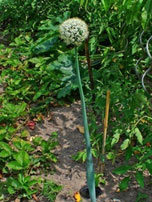SHAHEED KARTAR SINGH SARABHA AYURVEDIC MEDICAL COLLEGE & HOSPITAL
Affiliated to Guru Ravidas Ayurved University, Hoshiarpur Punjab
Affiliated to Guru Ravidas Ayurved University, Hoshiarpur Punjab

Botanical Name : Allium cepa Linn.
Family : Liliaceae; Alliaceae
Introduction :
Latin name: Album (onion) all = hot, burning; cepa = tomb(shaped like the dome of a mosque).
Scientific classification: Onions make up the genus Allium, of the family Liliaceae. The true onion is classified as Allium cepa; the nodding wild onion as Allium cernuum; the shallot as Allium ascalonicum; the chive as Allium schoenoprasum; and the green onion, or common leek, asAllium ampeloprasum.
Onion, common name for any of a genus of biennial herbs, of the lily family, native to Asia but cultivated in temperate and subtropical regions for thousands of years. The true onion is a bulb-bearing plant. Its long, hollow leaves with thickened bases make up most of the bulb. The white or pink flowers, which are borne in umbels, have six sepals, six petals, six stamens, and a solitary pistil. In the varieties known as top onions, the flowers are supplanted by bulblets, which may be grown to obtain new plants. The plant contains sulfurous, volatile oils that give it a characteristic pungent taste; one component readily dissolves in water to produce sulfuric acid, which may be produced in the eyes and induce tears.
Onions are one of the most versatile vegetables. They are eaten raw in salads, are cooked or pickled in a variety of ways, and are used as a flavoring or seasoning. Dehydrated onion products provide popular flavorings for soups and stews. Recent scientific studies indicate that onions may confer health benefits because they are rich in antioxidants, molecules that may have anticancer properties.
Onions raised in warm areas are planted as winter crops and are milder in taste and odor than onions planted during the summer in cooler regions. Yellow Bermuda and white Spanish onions are among the mildest cultivated onions.
Onions are easily grown from seed that may be either field-grown directly or planted in beds to produce small bulbs, or sets. These are commonly dried and shipped to gardeners and commercial growers. Onions are adaptable to temperature and can be planted year-round as long as the soil is rich and moist. They are sown four to six weeks before the last frost in the spring or are planted in late summer for a fall crop.
The crop is allowed to ripen in the field until tops begin to bend and break. The bulbs are then pulled up and spread or hung in a dry area to cure. Once dry, they are normally stored and shipped in slotted or open-mesh bags to keep them dry enough to prevent sprouting. United States commercial production of onions at the beginning of the 21st century exceeded 3,000,000 metric tons.
Other onions in the genus include the nodding wild onion, the shallot, the chive, and the green onion, or common leek. Both the shallot and the green onion, which have small bulbs, are also known as scallions.
Names in different Indian languages :
English : Onion
Hindi : Pyaj
Kannada : Nirulli
Malayalam : Cuvannulli, cheriya ulli
Sanskrit : Palaandu, Durgandh
Tamil : Venkaayam
Telugu : Ullipaya, ulligadda, erragadda
Unani : Piyaaz
Synonyms :
Tikshnakanda, Mukhadushana, Shudrapriya, Krumighna. Deepan. Mukhagandhaka, Durgandh
Varieties & adulterants – (CV – controversy, AD – adulterants) :
Varieties: 1) Red – raktaraj palandu – smaller in size and 2) White- shwetakshir palandu – larger in size.
Morphology :
The shrub grows to a height of 60 to 90 cms.
Leaves – thick, round and green with green coloured flower stalk at the top. It bears white flowers in clusters. These produce triangular seeds. Flowering and fruiting occurs after winter.
Distribution & Habitat :
All over India. Onions growing in Maharashtra are large in size.
Chemical constituents :
It contains an oil having pungent taste and offensive smell, sulphur. quercetin. sylapicrin. syliamarin, syllanineCycloallin, quercetin, oleanolic acid , allicin, alliin; flavonoids; phenolic acids and sterols
Properties :
Guna: Guru, snigdha:
Rasa: madhur. katu;
Virya: ushna
Vipaka: madhur;
Onions decrease vata and increase pitta.
Karma :
Krimighna, arsoghna, vatahara, deepana, pachana,
Antibiotic, antibacterial, antisclerotic, anticoagulant, anti-inflammatory, antiasthmatic, expectorant, carminative, antispasmodic, diuretic, hypotensive, antidiabetic.
Indication :
Krimi, arsas, medhas,
Ulcers, wounds, fever, skin disease, cough, piles, leucorrhoea, mouth ulcers,Eczema, ,pruritus, diabetes ,leucoderma,anorexia
Part used :
Bulb
Uses :
Analgesic, anti-inflammatory, tonic, enhances eyesight and reduces otalgia. Pain due to bronchitis is controlled with a warm poultice of grated onion. In skin infections, onion is applied externally as a poultice. In weak eyesight, onion juice mixed with honey is used as eye drops. In ear ache, warm onion juice is. used as eardrops.
Internal uses : Onions reduce vata and cause an increase in raja and tama. It is therefore useful in arthritic pain, sciatica, hysteria and hydrophobia. It improves digestion and helps in constipation, piles and jaundice. Onions are also used in rectal prolapse. It is useful in cardiac debility, bleeding disorders, dry cough, dysuria, azoospermia, irripotency, dysmenorrhoea, cholera, plague and skin. diseases.
Onions are not beneficial to those with pittaprakruti and brain weakness. The antidote in these cases is pomegranate juice.
Dosage : Dose: Juice – 10 to 30m1. Seed powder – 1 to 3 gms.
